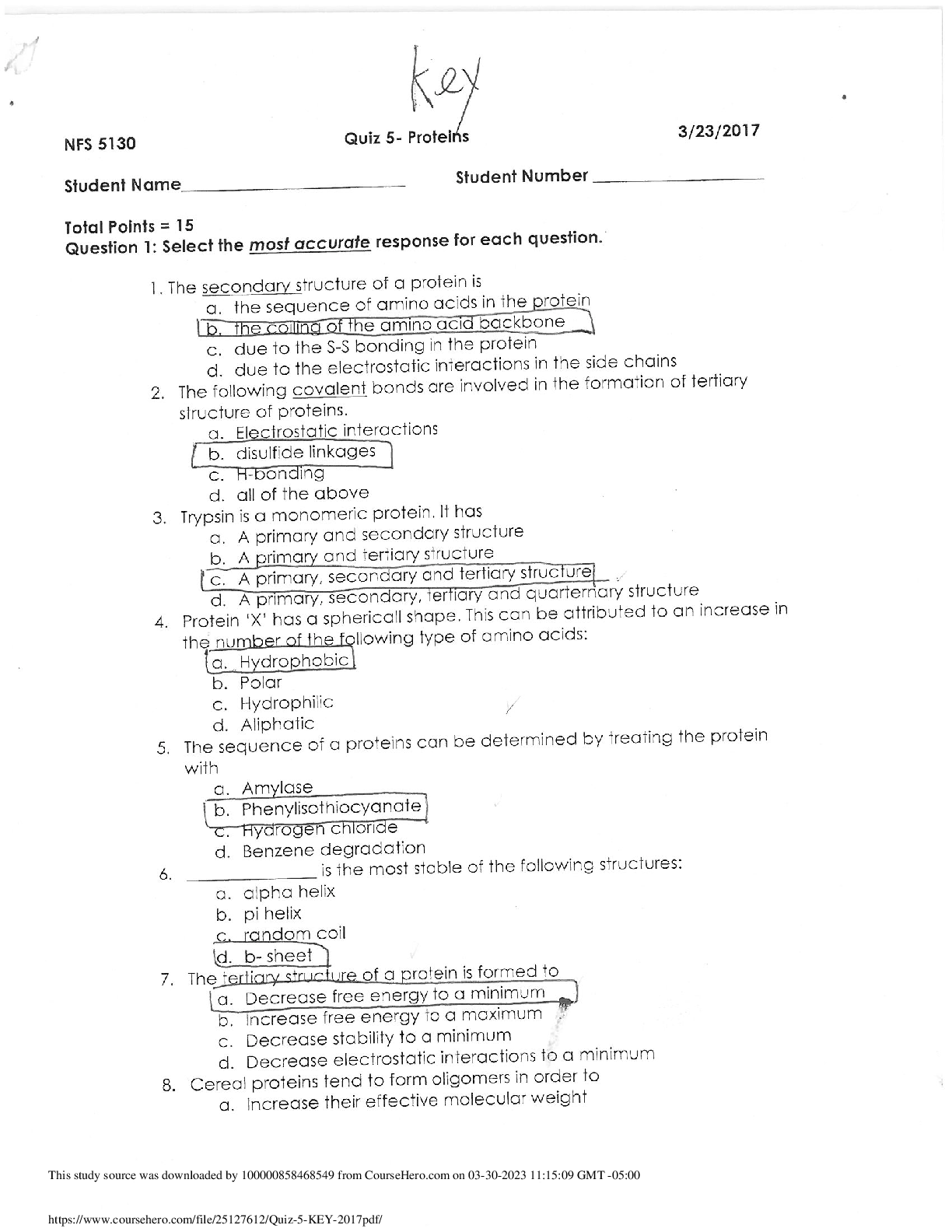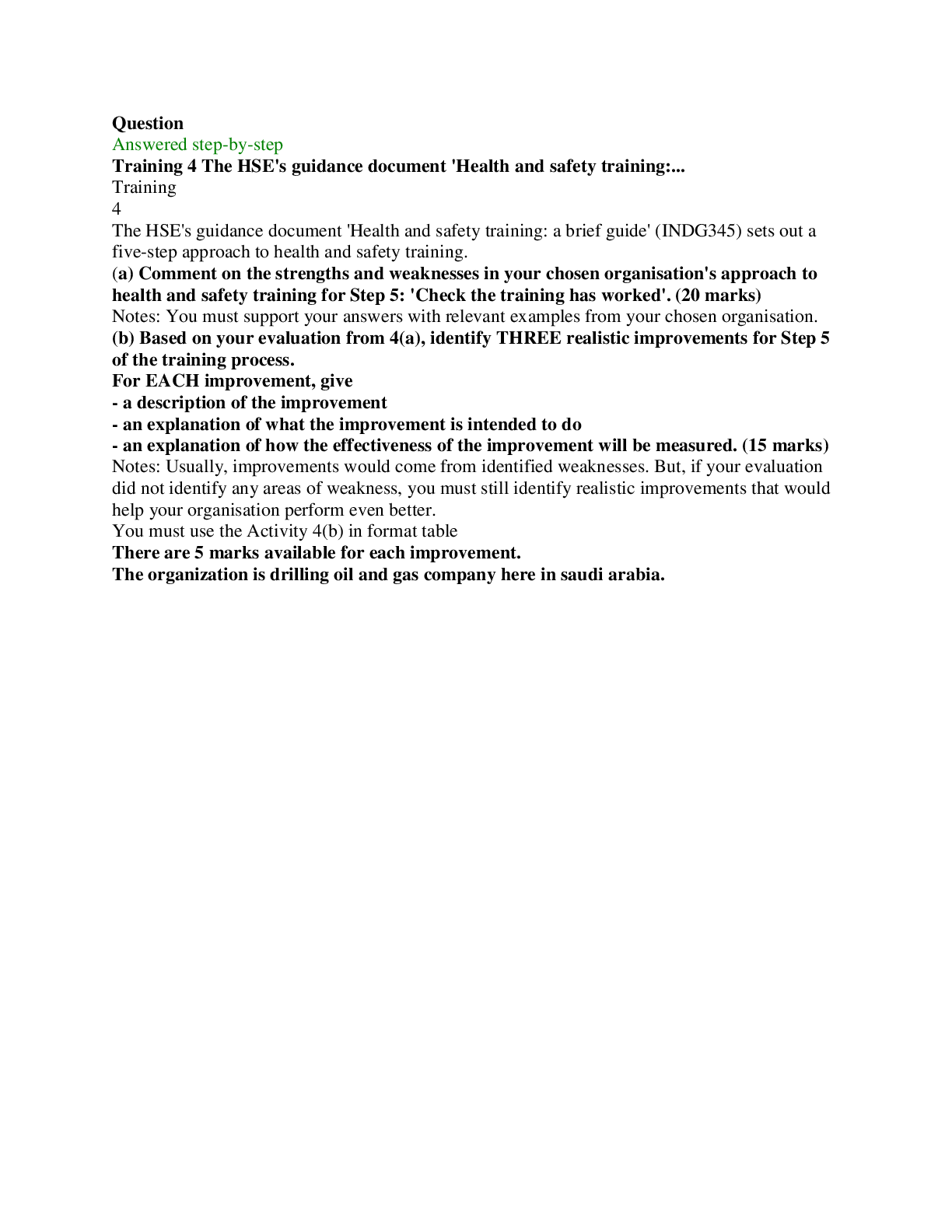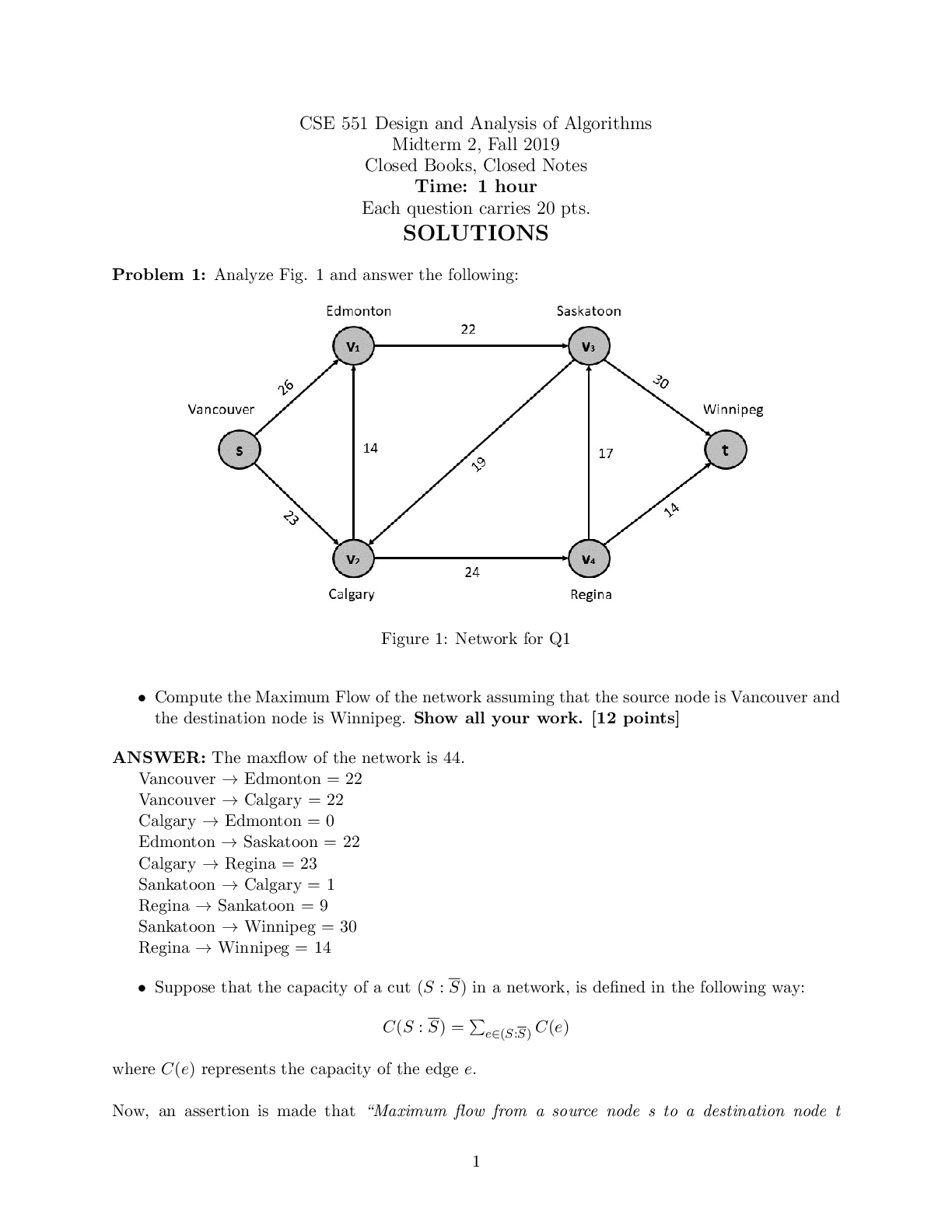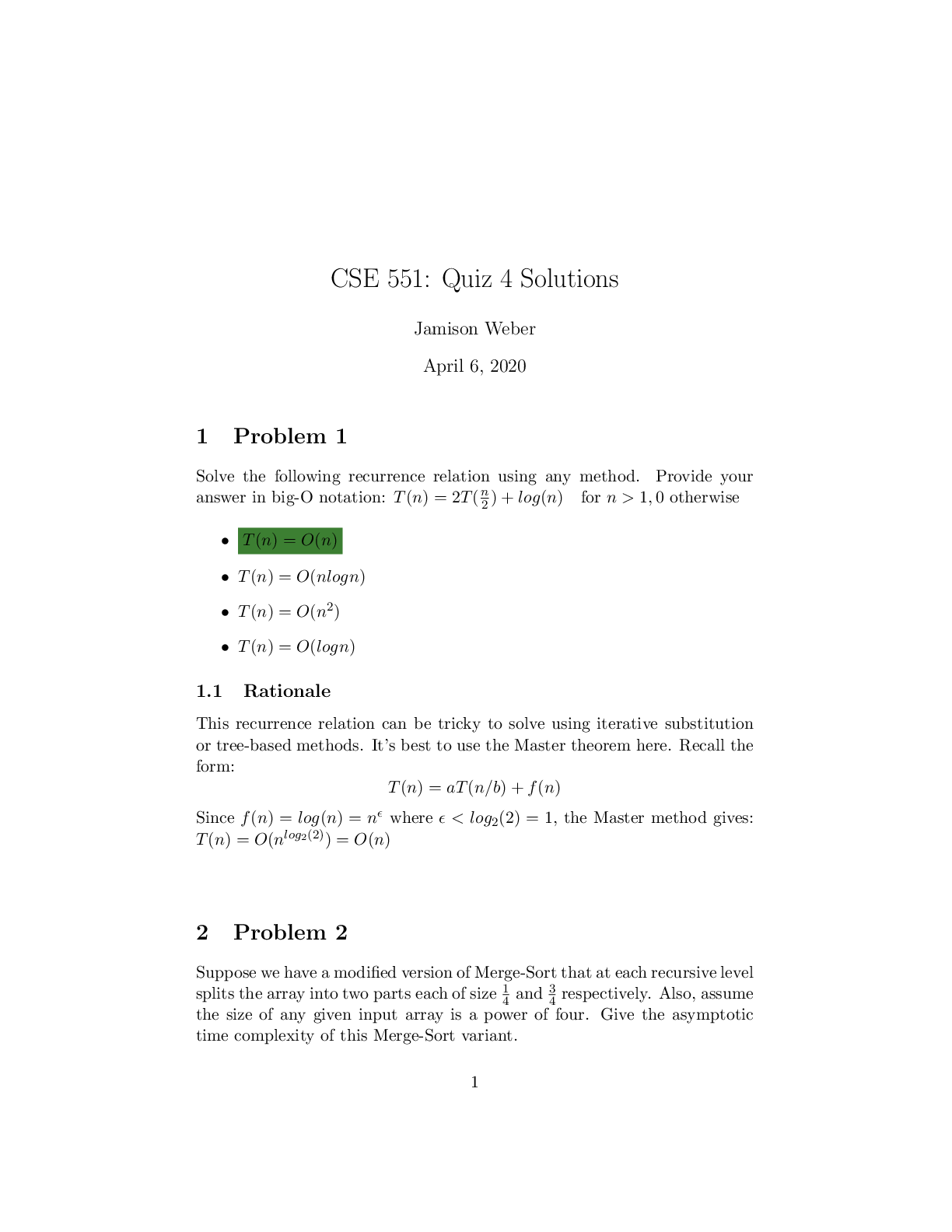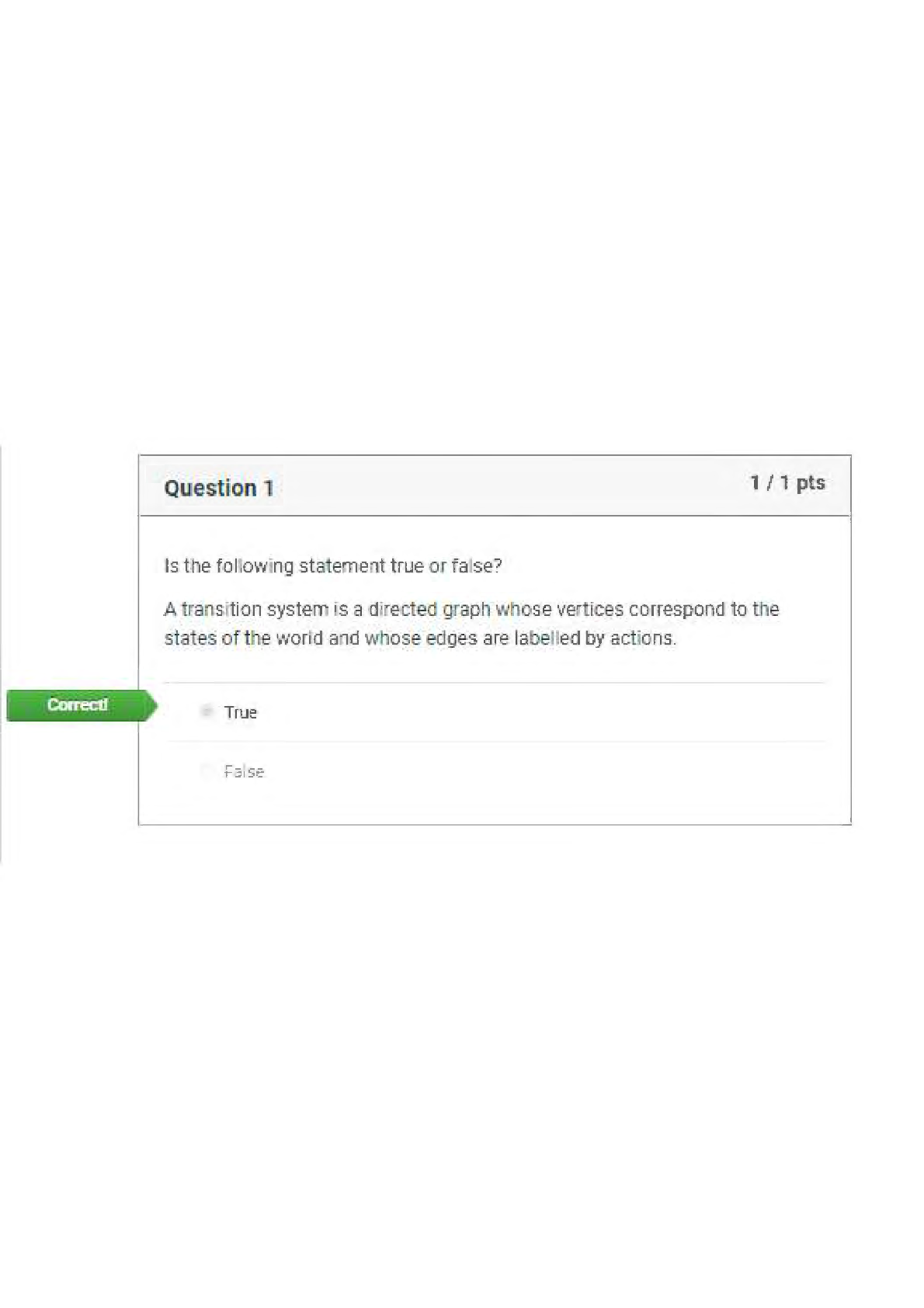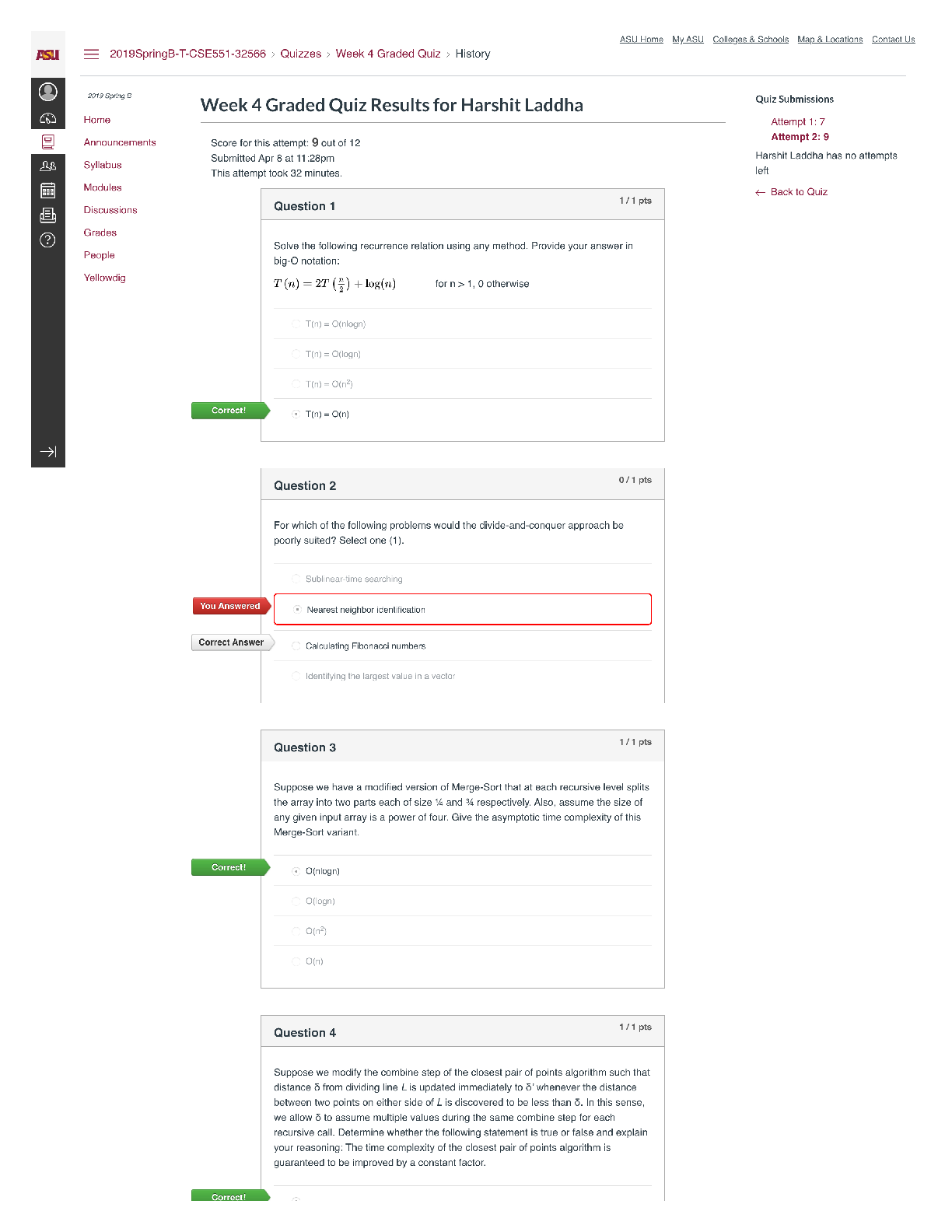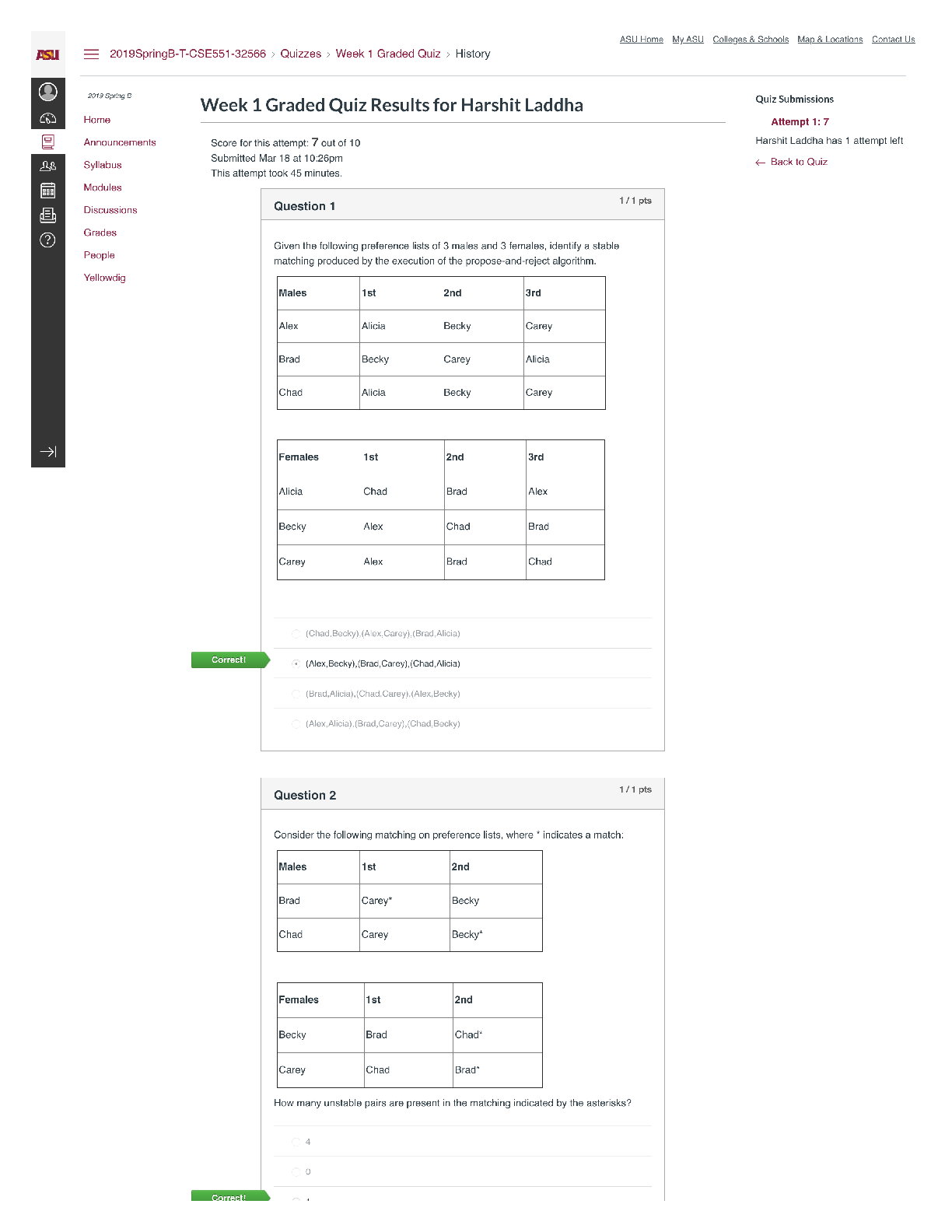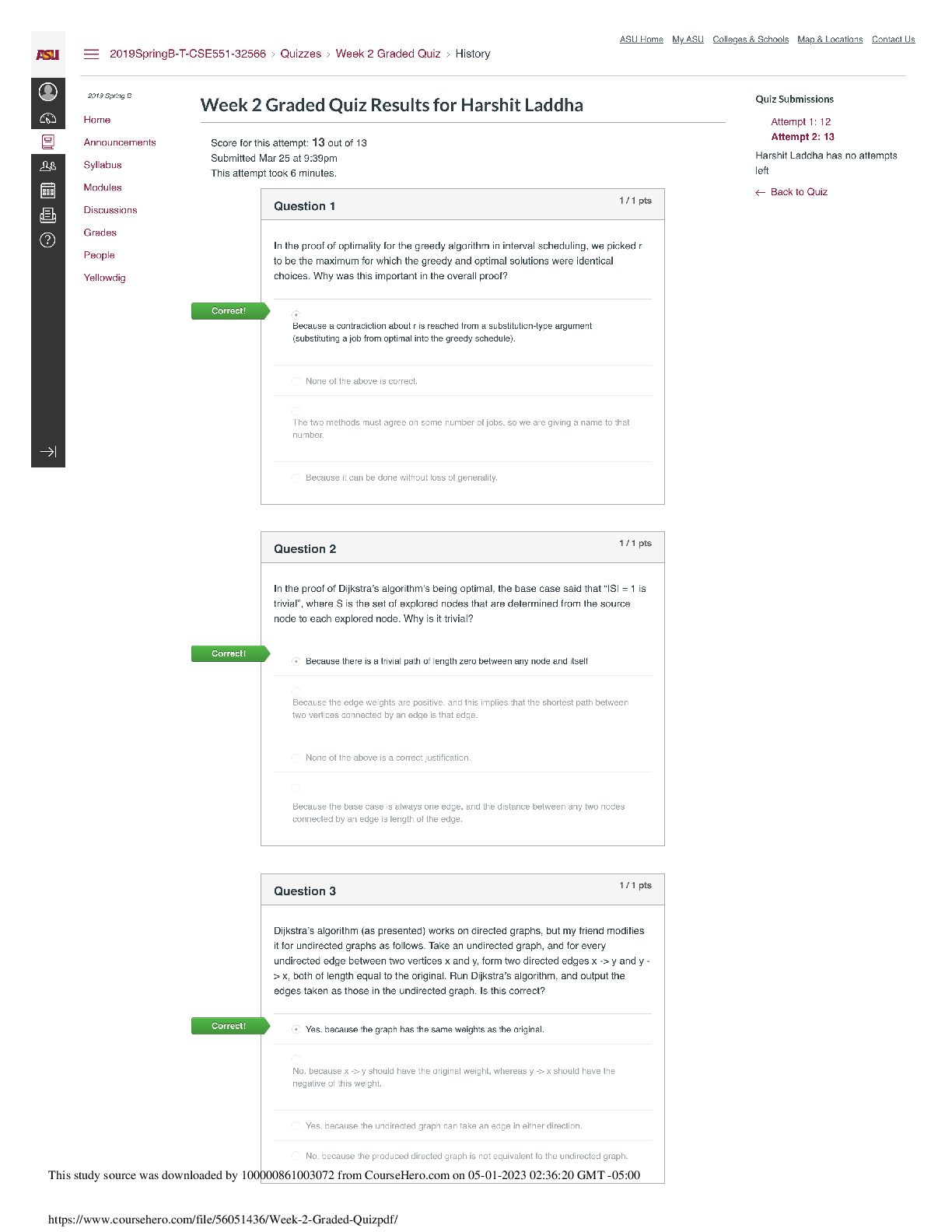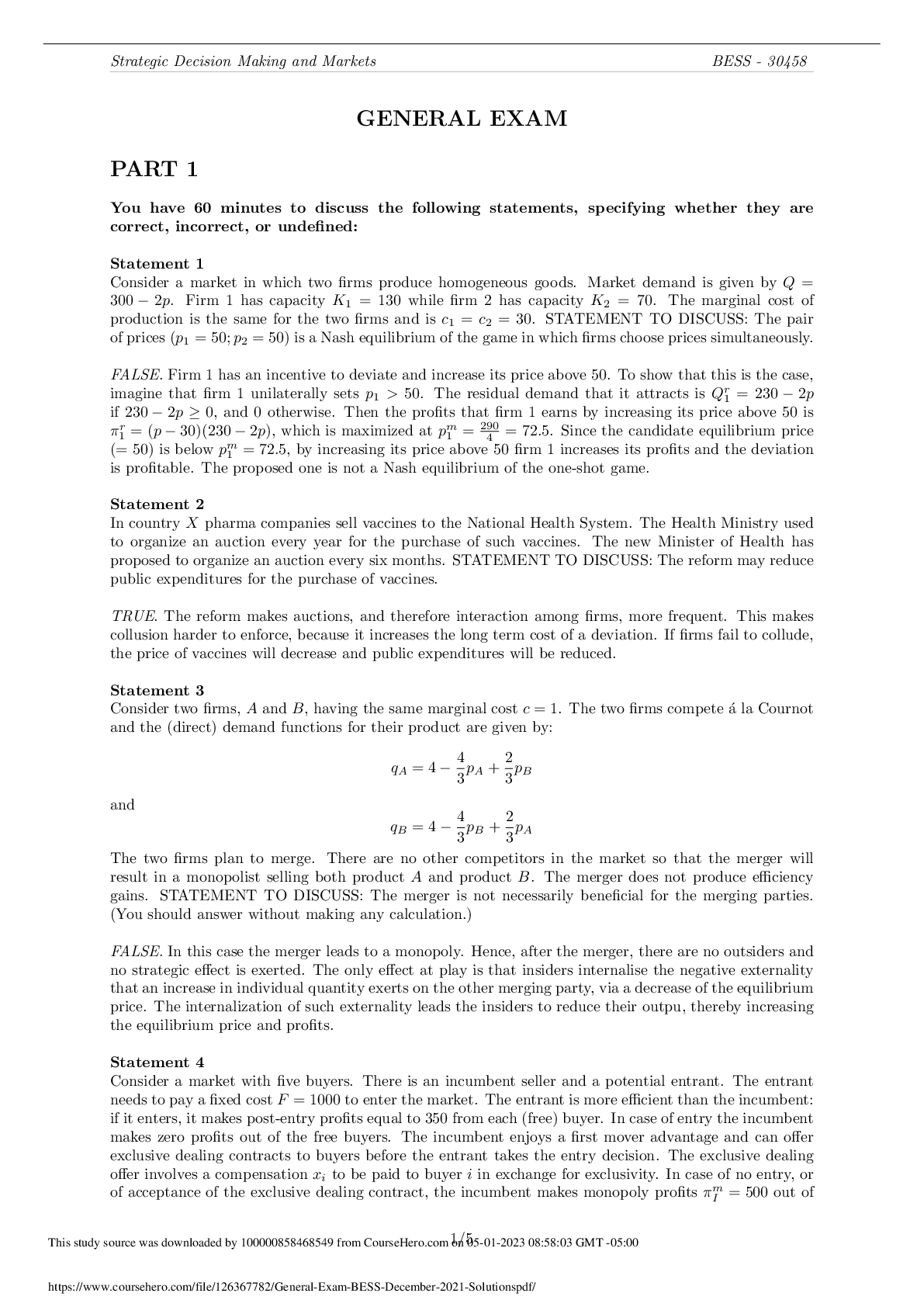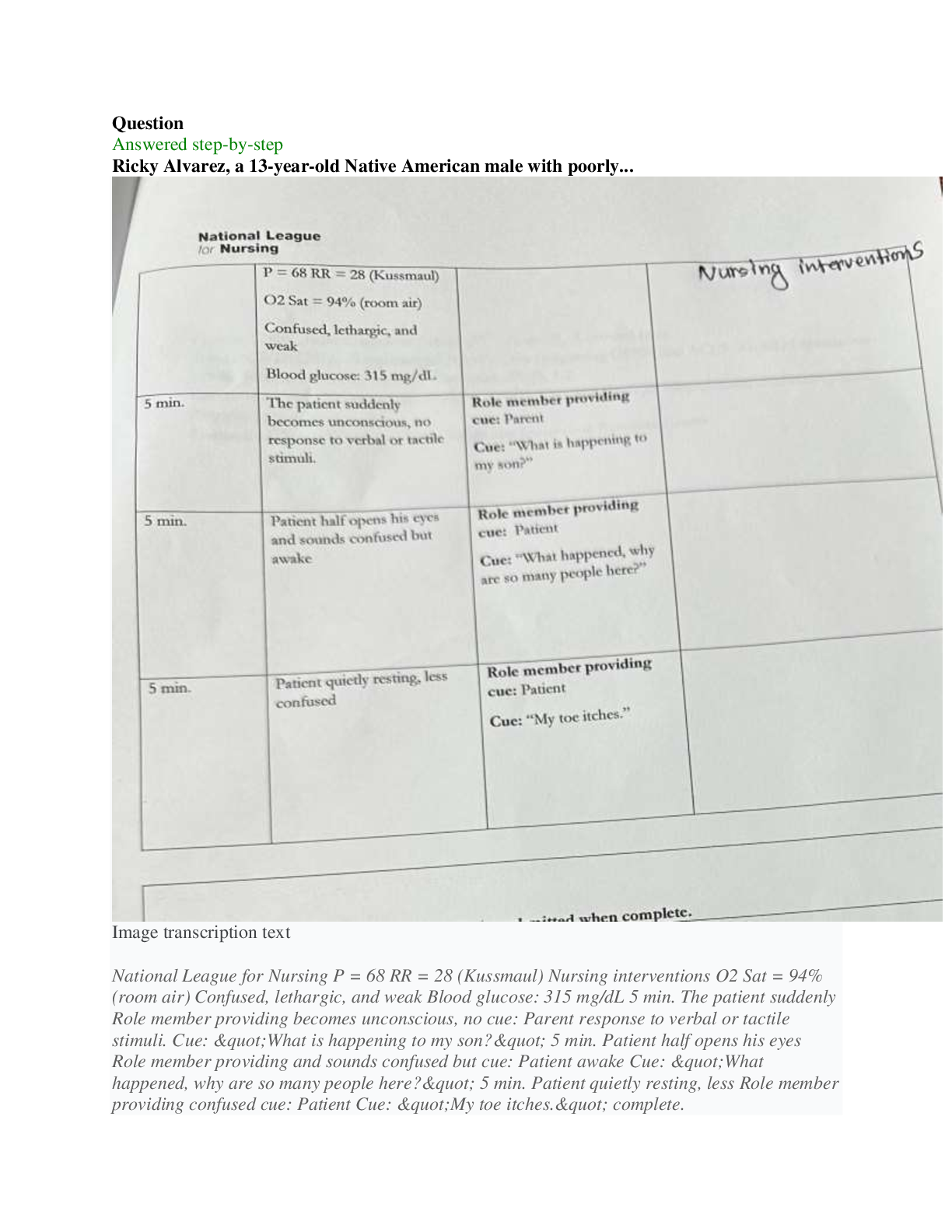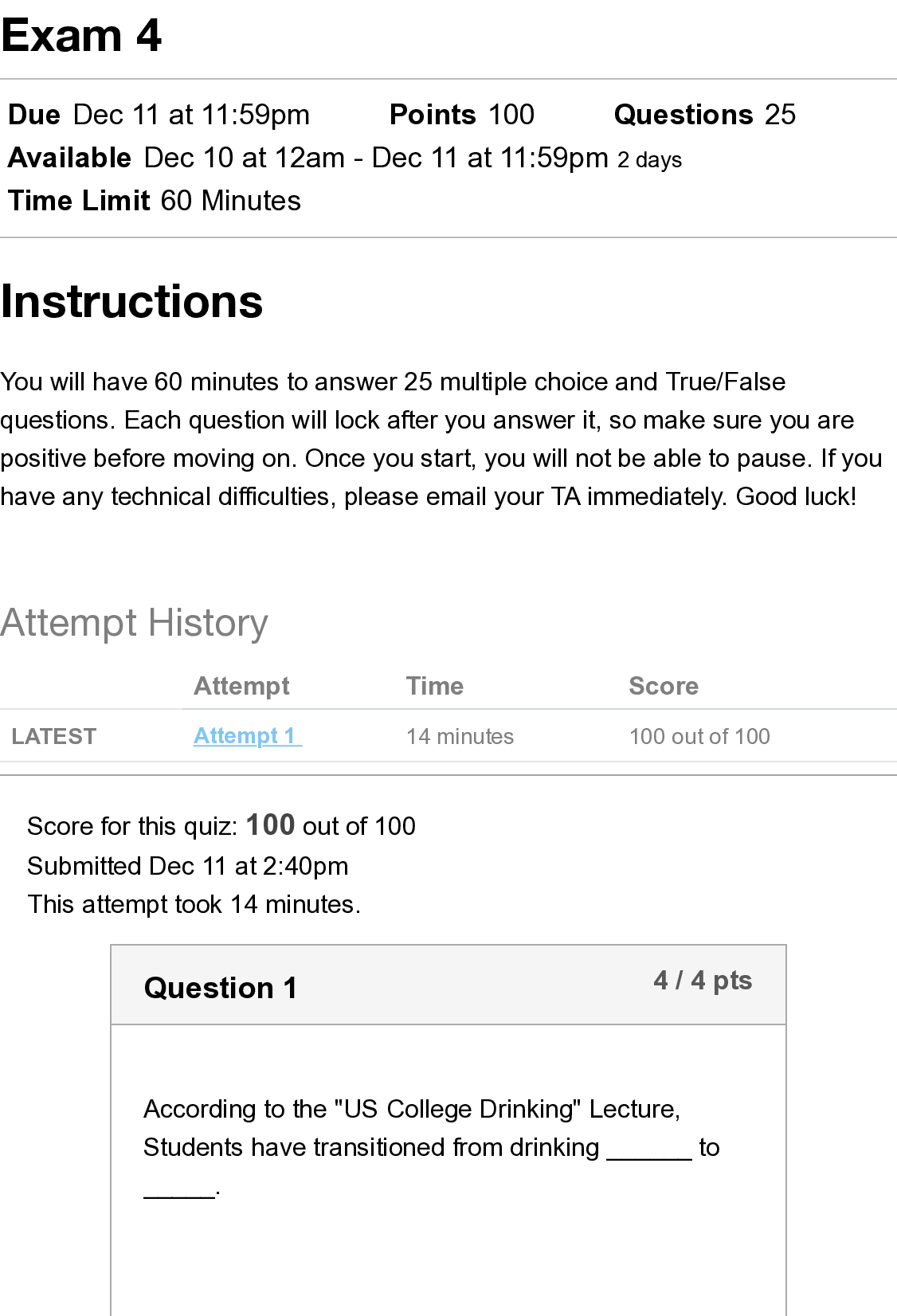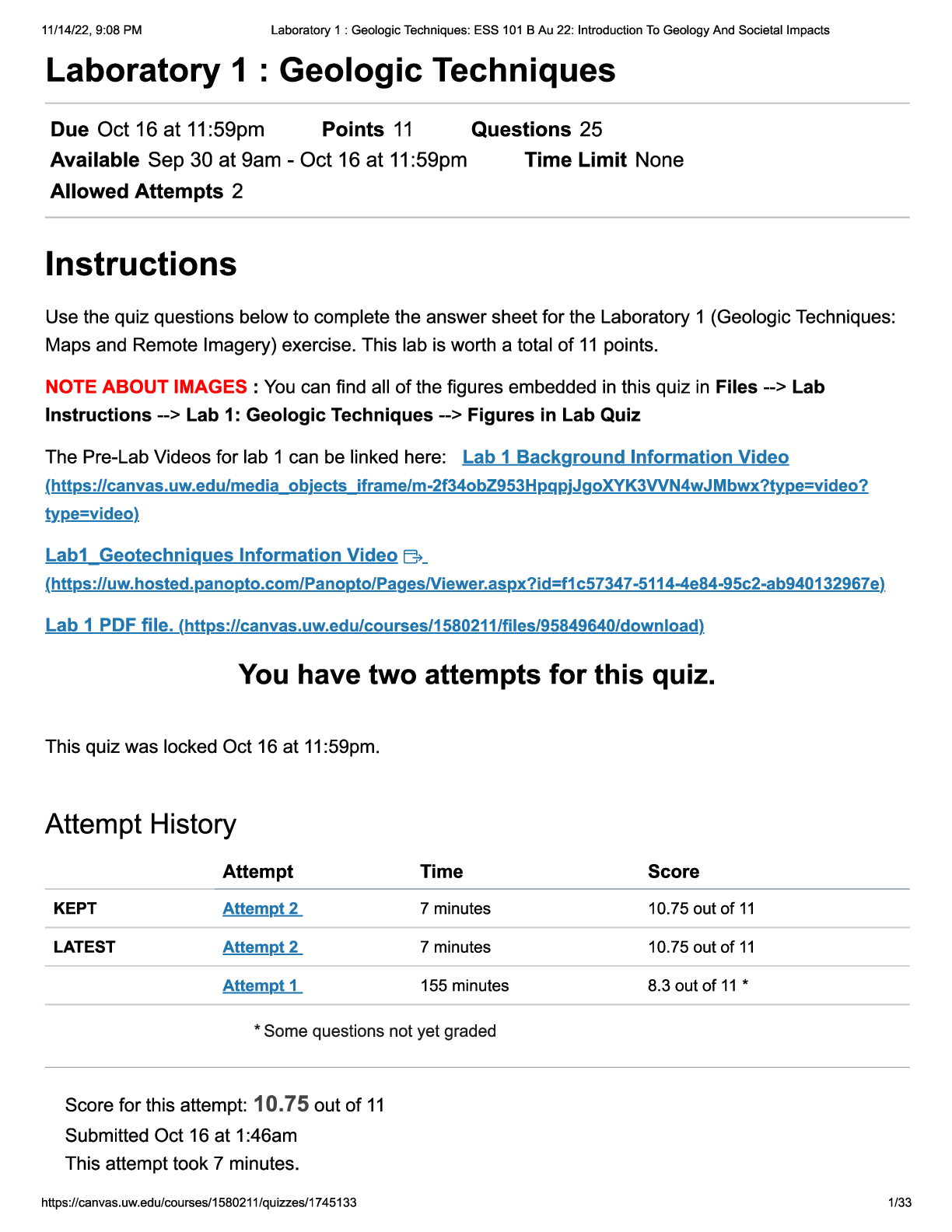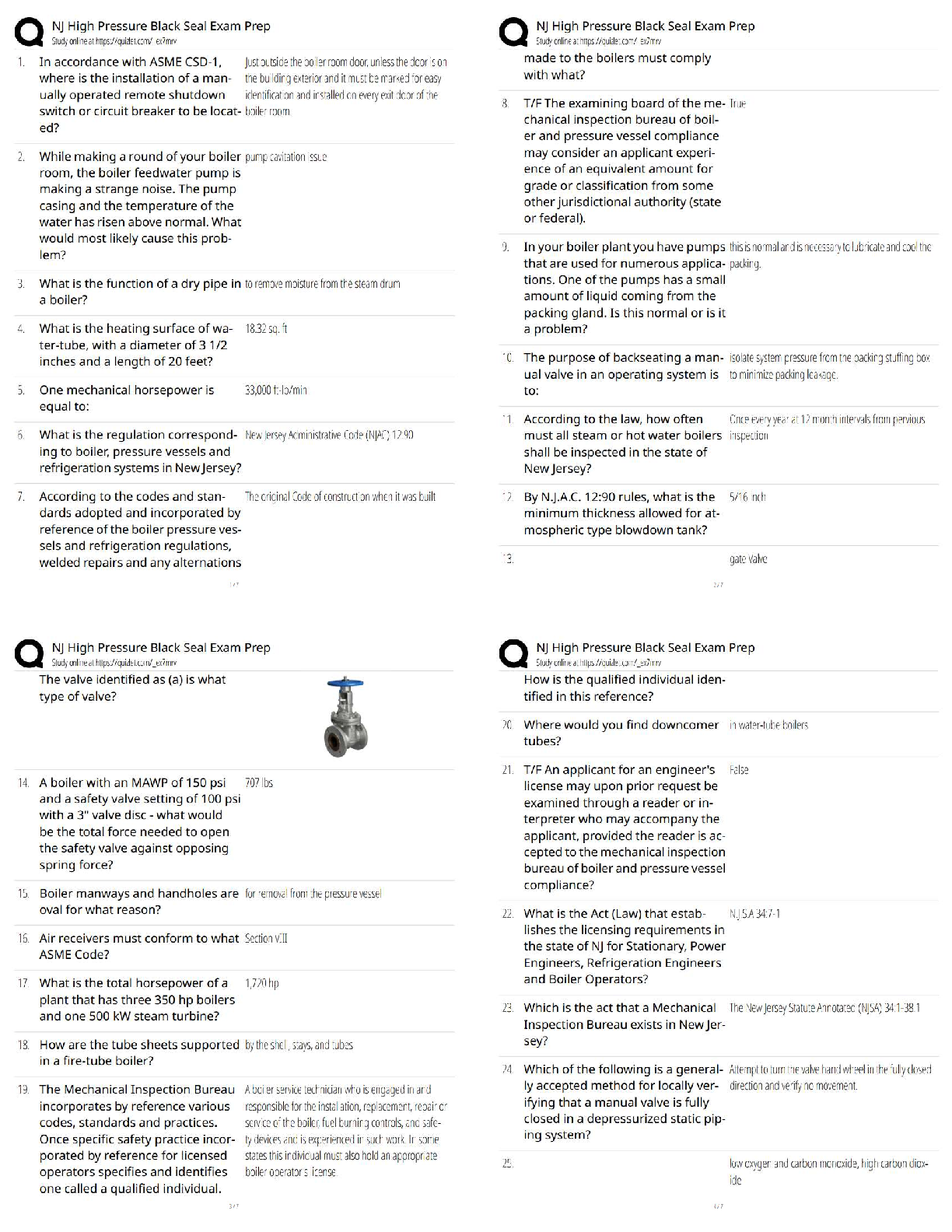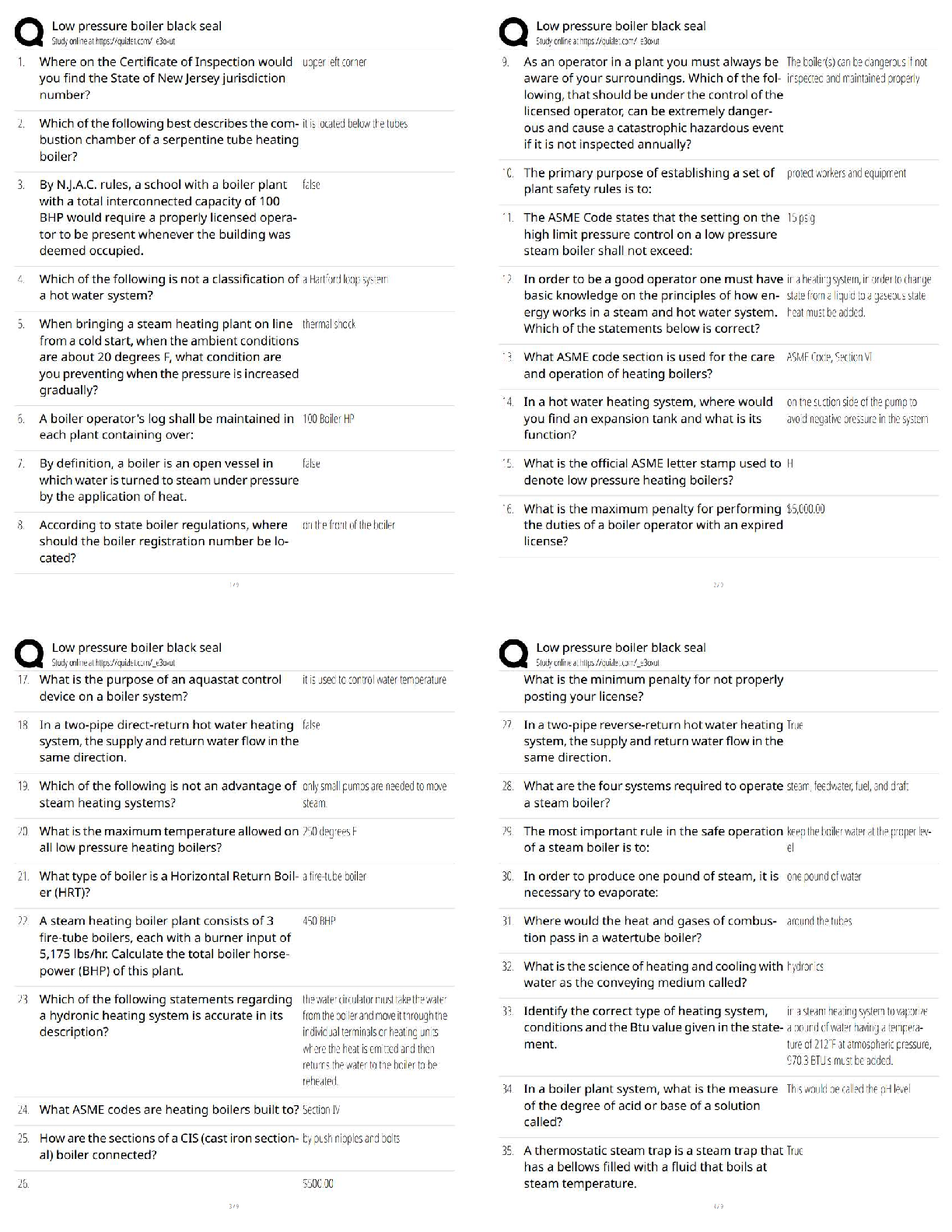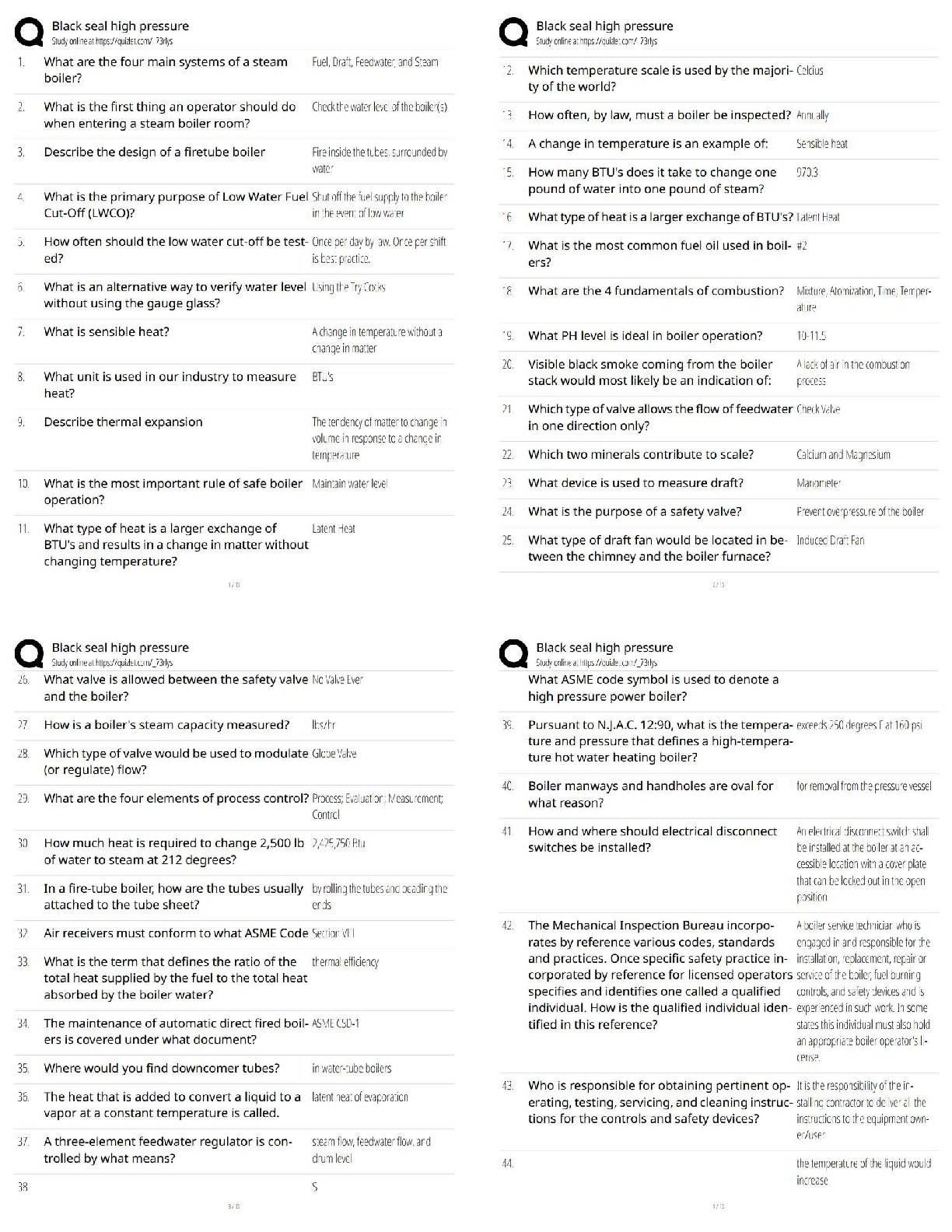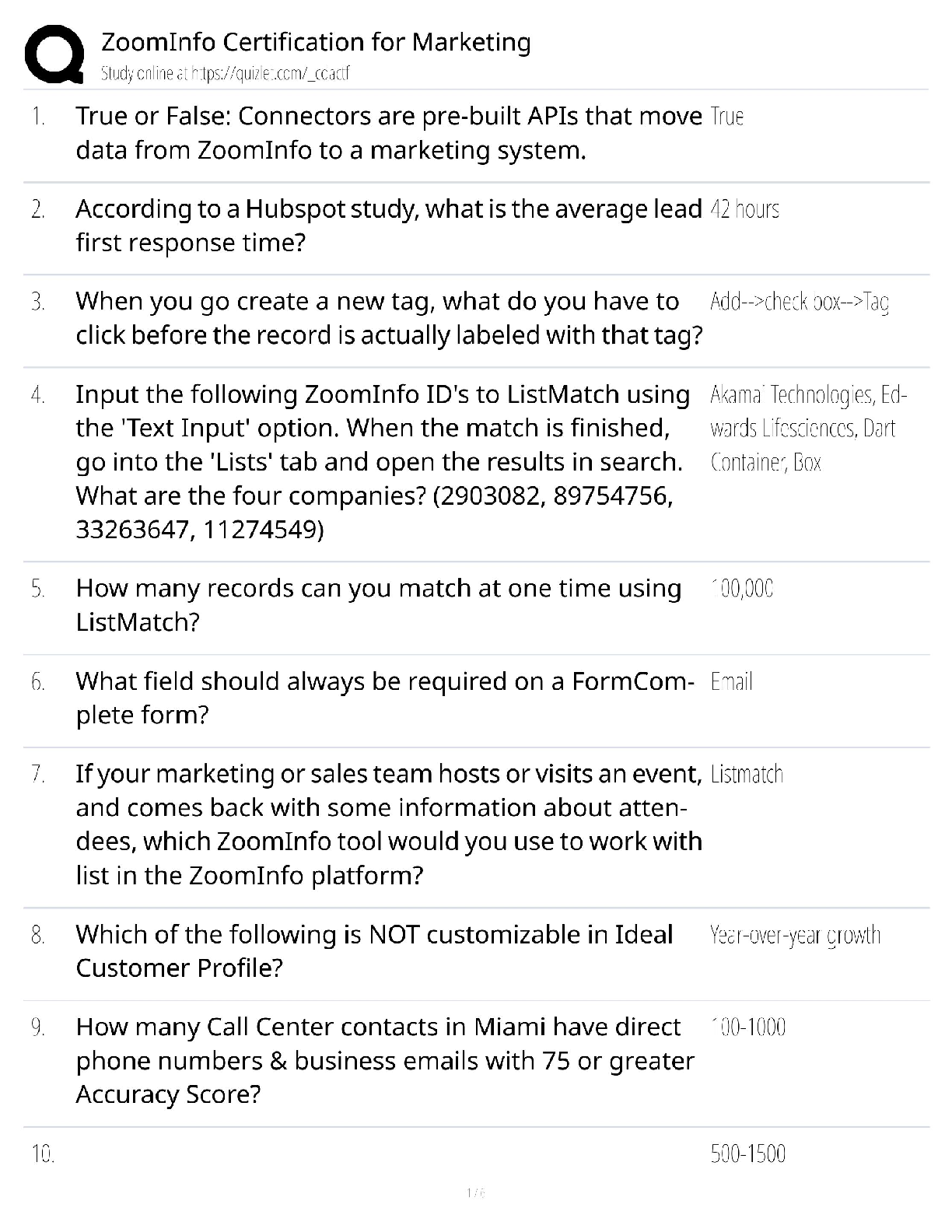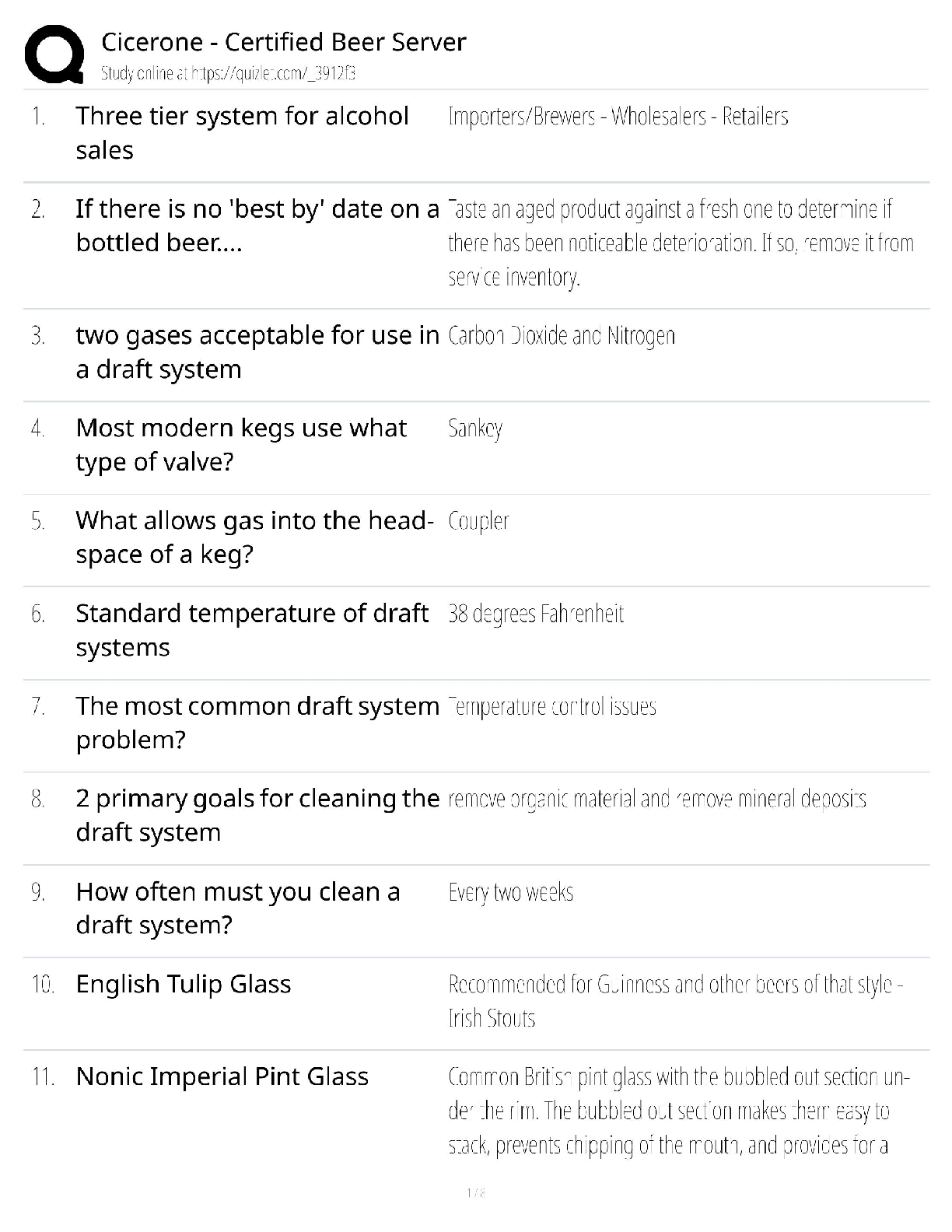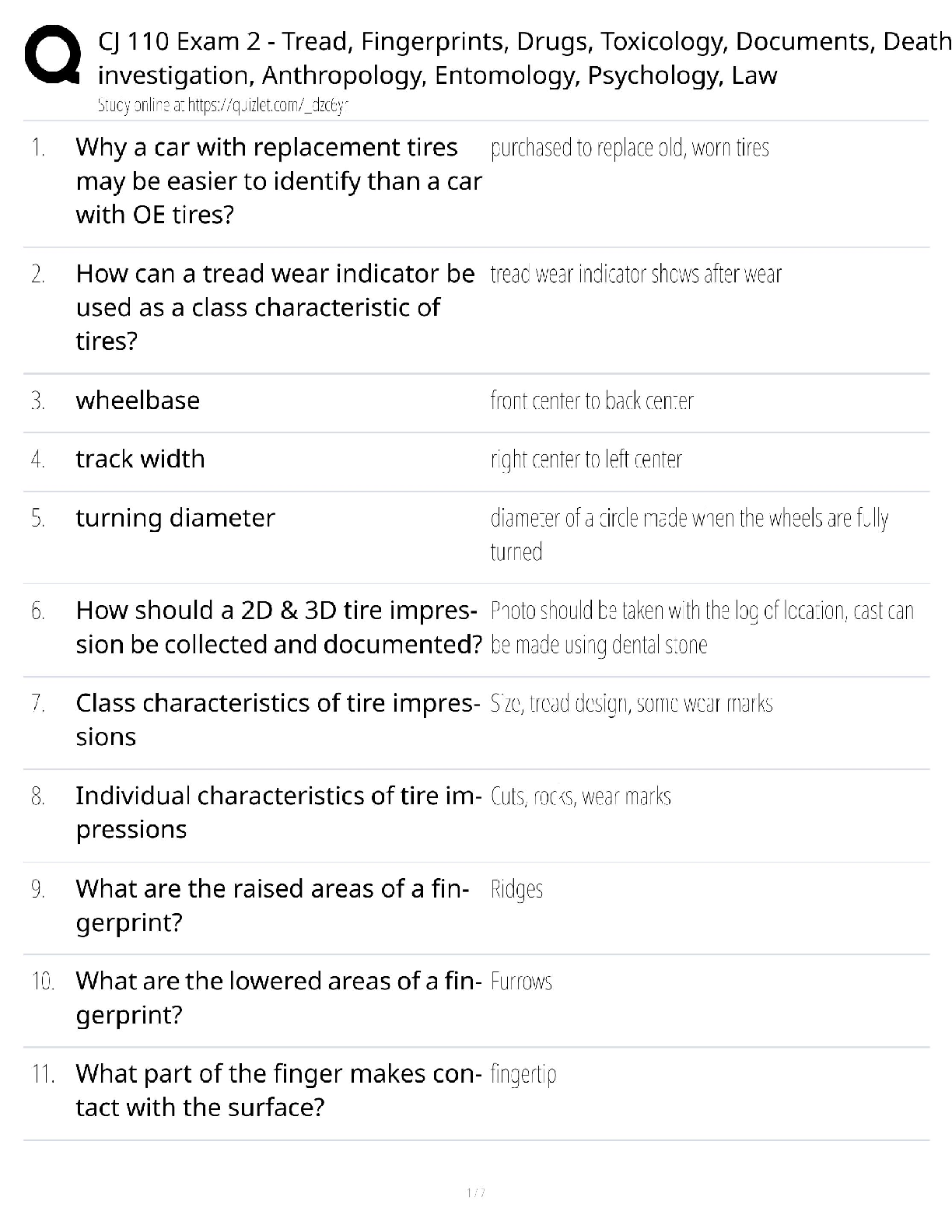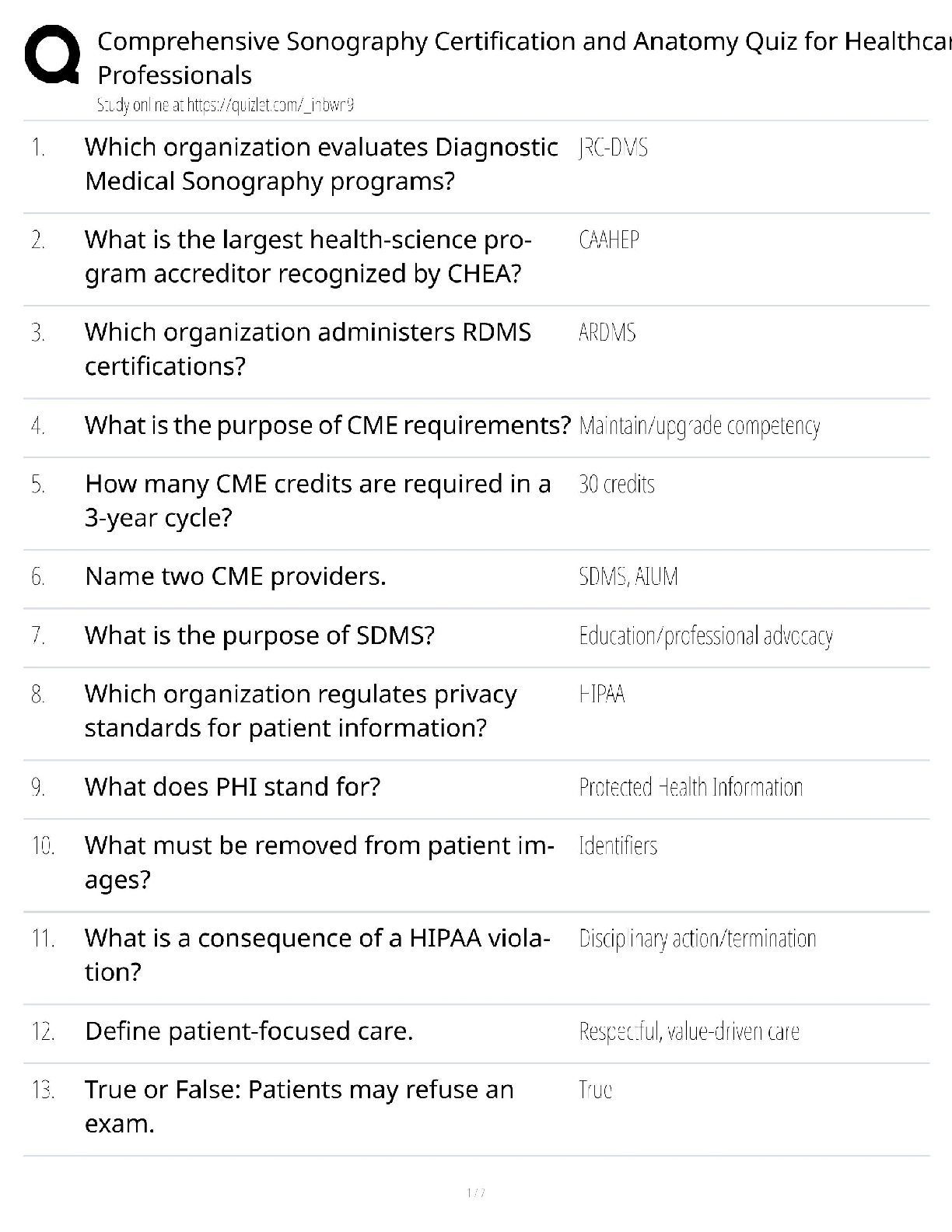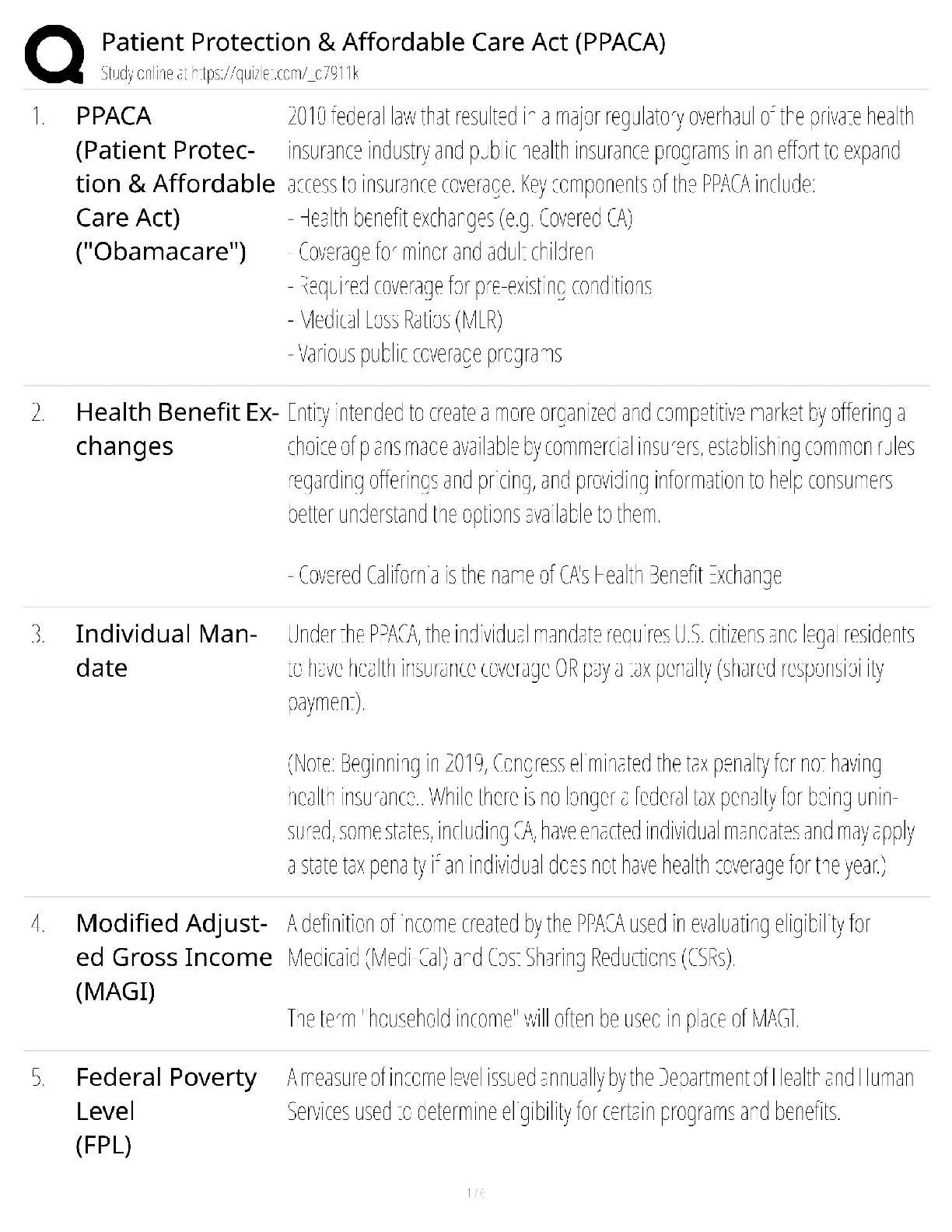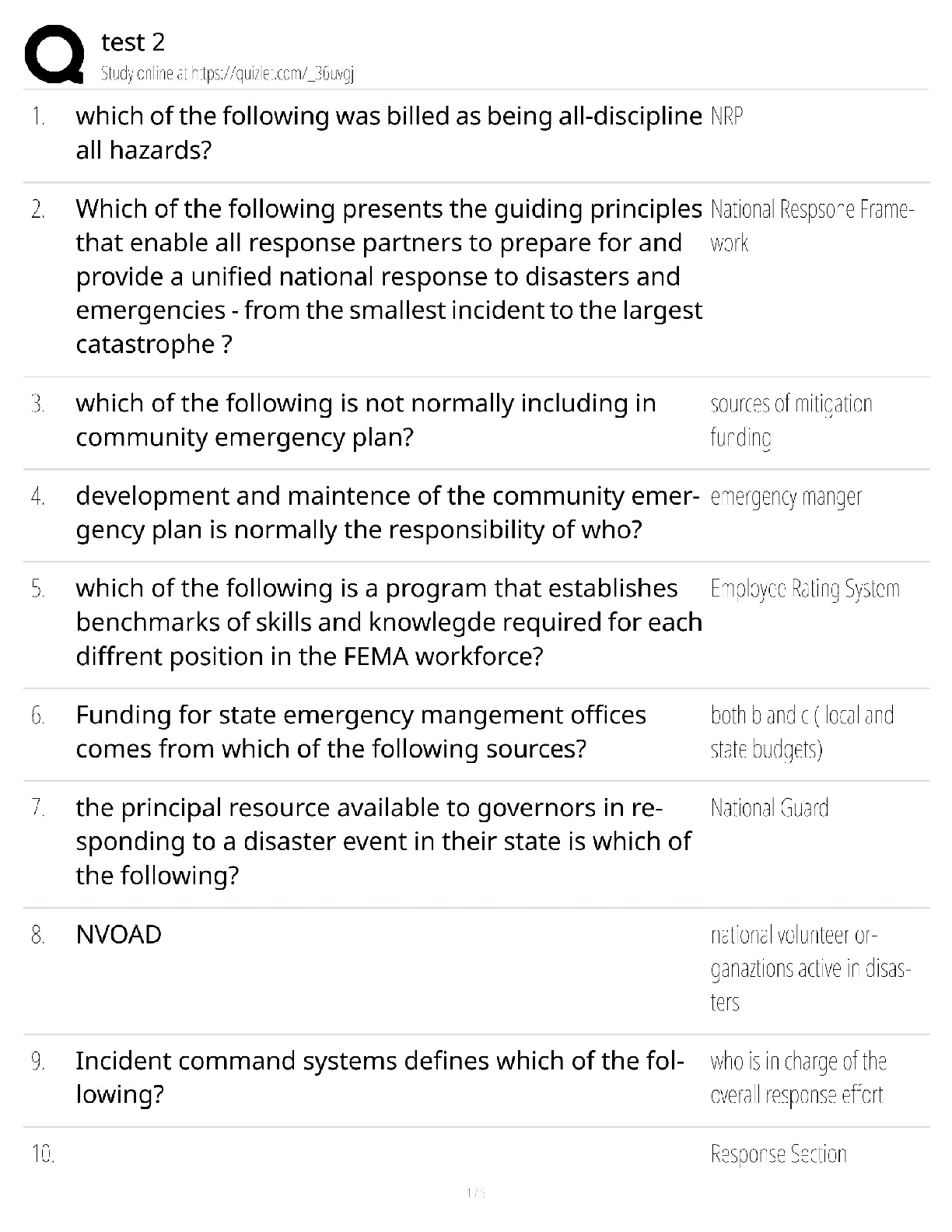Biology > QUESTIONS & ANSWERS > BIOL 1150/51 Lecture Exam #2. Best Last Minute Exam Preparation/ Study Guide. Contains 40 Questions (All)
BIOL 1150/51 Lecture Exam #2. Best Last Minute Exam Preparation/ Study Guide. Contains 40 Questions and Answers.
Document Content and Description Below
BIOL 1150/51 Lecture Exam #2 Name________________________________________ 1. What types of cells are humans made up of? a. Prokaryotic b. Eukaryotic 2. A chemical bond that results from the sharin ... g of electrons between two atoms where one atom has a higher affinity for electrons than the other is called a: a. Polar covalent bond b. Nonpolar covalent bond c. Ionic bond d. Hydrogen bond 3. If an atom has a charge of -1 which of the following must be true? a. The atom has the same number of protons and electrons b. The atom has one more proton than electrons c. The atom has one more proton than neutrons d. The atom has one more electron than protons 4. You isolate a large biological molecule and determine that it is entirely non-polar. Because of this molecular property you can guess that this molecule is most likely composed of: a. Fatty acids b. Nucleic acids c. Amino acids d. Carbohydrates 5. Which of the following solutions would be considered more basic (alkaline) than a solution with a pH = 7? a. Solution 1: pH = 1 b. Solution 2: pH = 7 c. Solution 3: pH = 14 6. Which are specialized cells found at the base of the epidermis that produce pigments designed to protect the body from the damaging effects of ultraviolet radiation? a. Melanin b. Melanocytes c. Basal d. Lacuna 7. Cholesterols are lipids that are commonly found in the membranes of eukaryotic cells. In what region of the phospholipid bilayer would you expect to find cholesterol embedded? a. On the extracellular surface of the membrane contacting the extracellular fluid b. Within the non-polar intra-membrane region formed by the phospholipid tails c. On the intracellular surface of the membrane contacting the cytoplasm 8. Which of the following organelles are found in both prokaryotic and eukaryotic type cells? a. Golgi bodies b. Ribosomes c. Nucleus d. Lysosomes This study source was downloaded by 100000810073548 from CourseHero.com on 04-12-2022 10:28:27 GMT -05:00 https://www.coursehero.com/file/32610906/F14-BIOL-1150-Lecture-Exam-2-with-Keydoc/9. Sperm cells require large amounts of ATP for activity. You would expect these cells to have a larger volume of : a. Smooth endoplasmic reticulum b. Rough endoplasmic reticulum c. Nucleus d. Mitochondria 10. Which organelle is responsible for the synthesis of proteins: a. Smooth endoplasmic reticulum b. Rough endoplasmic reticulum c. Nucleus d. Mitochondria 11. To change the atomic weigh of a particular element (make an isotope) you would need to change the number of: a. Electrons b. Protons c. Neutrons d. Both a & b could change the weight of that element e. Both b & c could change the weight of that element 12. Which of the organelles is responsible for the production of phospholipids? a. Mitochondria b. Golgi complex c. Smooth endoplasmic reticulum d. Lysosomes 13. The oxygen requiring processes of cellular respiration occur within the________. a. Cytoplasm b. Nucleus c. Mitochondria d. Lysosomes 14. Which of the following is true of enzymes? a. They only create ATP molecules b. They are consistently broken down in reactions c. They lower the energy required for a reaction to occur d. They are frequently carbohydrates 15. The largest organ of your body is ________. a. Your heat b. Your lungs c. Your skin d. Your colon 16. Alchemists were medieval scientists that often spent their lives attempting to turn lead (atomic number 82) into gold (atomic number 79). What sub-atomic particle would they have had to manipulation in order to make this change occur? a. Protons b. Neutrons c. Electrons This study source was downloaded by 100000810073548 from CourseHero.com on 04-12-2022 10:28:27 GMT -05:00 https://www.coursehero.com/file/32610906/F14-BIOL-1150-Lecture-Exam-2-with-Keydoc/17. A person exposed to continuous sunlight is likely to be making which vitamin within his or her body? a. Vitamin A b. Vitamin B c. Vitamin C d. Vitamin D 18. Suppose that a new poison has just come onto the market that will kill any organism without a nucleus. Which type of organism is most likely to survive? a. Plants b. Archaea c. Bacteria d. Prokaryotes 19. The process by which molecules travel with the concentration gradient and pass through the cell membrane with the assistance of a protein is called ________. a. Facilitated diffusion b. Diffusion c. Osmosis d. Active transport 20. Which is a membranous organelle that chemically modifies and ships proteins to other organelles or out of the cell? a. Lysosome b. Chloroplast c. Mitochondria d. Golgi complex 21. Most of the energy used by the cell is converted to ATP during ________. a. Glycolysis b. The Kreb’s cycle c. The electron transport chain d. Gluconeogenesis 22. White blood cells (macrophages) in the reticuloendothelial system recycle worn out red blood cells and digest foreign invaders. Which organelles would you expect to be especially numerous in these cells? a. Nuclei b. Mitochondria c. Golgi complexes d. Lysosomes 23. Which of the following cells form new calcified bone in bone tissue? a. Osteoclasts b. Osteoblasts c. Osteocytes d. Fibroblasts 24. What forms within the spaces of spongy bone and functions to produce blood cells? a. Yellow marrow b. Osteons c. Osteocytes d. Red marrow This study source was downloaded by 100000810073548 from CourseHero.com on 04-12-2022 10:28:27 GMT -05:00 https://www.coursehero.com/file/32610906/F14-BIOL-1150-Lecture-Exam-2-with-Keydoc/25. Calcium intake is of concern to women during pregnancy. If a woman for whatever reason does not get enough calcium in her diet during pregnancy, what is likely to happen to her bone tissue? a. She will experience severe bone loss due to the loss of estrogen production during pregnancy. b. She may experience some bone loss due to the lack of calcium in her diet, but nothing significant. c. She may experience significant bone loss both due to the lack of calcium and the fact that the fetus requires extra calcium that will be removed from her own bone tissue. d. The baby will be born without a skeleton. 26. A chemical reaction that creates a more ordered structure by removing water, creating polymers from monomers is called_______. a. An hydrolysis reaction b. A condensation reaction. c. A phosphorylation reaction. d. An overreaction. 27. Straps of connective tissue that hold bones together, support joints, and direct movement are known as ________. a. Tendons b. Ligaments c. Bursae d. Cartilage 28. Bands of connective tissue that aid in the attachment of muscles to bones are termed ________. a. Ligaments b. Cartilage c. Tendons d. Fibrocartilage 29. Monosaccharides, disaccharides, and polysaccharides are all _________. a. lipids b. carbohydrates c. monomers d. proteins 30. The ability of the human body to maintain a relatively constant internal environment is known as ________. a. Homeostasis b. Positive feedback c. Stabilization d. Regulation 31. The membranes of our cells are made mostly of _____. a. Proteins b. Polysaccharides c. Nucleic acids d. Lipids This study source was downloaded by 100000810073548 from CourseHero.com on 04-12-2022 10:28:27 GMT -05:00 https://www.coursehero.com/file/32610906/F14-BIOL-1150-Lecture-Exam-2-with-Keydoc/32. Which of the following contains the most cells? a. An organ system b. An organism c. An organ d. A tissue 33. Which of the following is a kind of lipid? a. Enzyme b. Sucrose c. Triglyceride d. Sodium Chloride 34. When your exercise exceeds your aerobic conditioning, your muscles may ache due to the presence of __________________. a. ATP b. Glucose c. Lactic Acid d. Alcohol 35. Which of the following is a product of cellular respiration? a. Glucose b. Oxygen c. Amino acids d. Energy Short Answer (chose any three of the following) 1. Explain the difference between saturated and unsaturated fatty acids. What are they “saturated” with? What do their tails look like? How do the properties of the tails influence the consistency of the fatty acid at room temperature? 2. A red blood cell has a cytoplasmic physiological saline (Na+) concentration of 0.9%. You place this organism in a beaker of salt water with a saline concentration of 2.0%. What happens to the cell? Is the cell hypotonic, hypertonic or isotonic relative to the solution? 3. Describe the similarities and differences between osteoblasts, osteoclasts and fibroblasts. What are the roles of each of these cell types in bone remodeling? 4. Outline the names of the three basic steps in cellular respiration. Note generally where each of these reactions occurs and the amount of ATP produced in each step. Also explain the importance of the electron carriers generated during this process. 5. Compare and contrast diffusion, facilitated diffusion and active transport mechanisms, and give an example of a type of molecule (charged, uncharged, polar, non-polar that crosses using each of these mechanisms. 6. Describe three of the properties of water that make it such an effective molecule for supporting life. Be sure to include how each of these properties is beneficial to life as we know it. [Show More]
Last updated: 3 years ago
Preview 1 out of 5 pages

Buy this document to get the full access instantly
Instant Download Access after purchase
Buy NowInstant download
We Accept:

Reviews( 0 )
$8.00
Can't find what you want? Try our AI powered Search
Document information
Connected school, study & course
About the document
Uploaded On
Apr 12, 2022
Number of pages
5
Written in
All
Additional information
This document has been written for:
Uploaded
Apr 12, 2022
Downloads
0
Views
110

